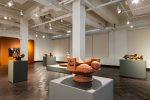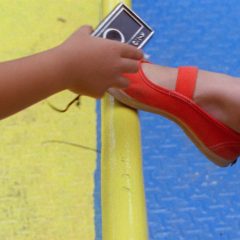How can art engage with the legacy of the past, still so alive in a historic city like Charleston, SC? Founded in 1670, Charleston is best known as the birthplace of the Civil War, which began on April 12, 1861, when Confederate troops opened fire on Fort Sumter. Nowadays, Charleston is a popular tourist destination, named in 2015 by Condé Nast as the number one American small city to visit for the fifth year in a row. Tourists come to see the city’s historic architecture and experience its famous Southern charm–and eat its delicious cuisine.
But behind this romantic vision of Charleston is the painful history of slavery, as well as ongoing racism and inequality. The city found itself at the center of national debates about racism, gun violence, and the legacy of the past following last year’s massacre at Emanuel African Methodist Church, known as Mother Emanuel. Nearly one year ago, on June 17, 2015, Dylann Roof walked into an evening prayer meeting and opened fire, killing nine people. Mother Emanuel is one of the most historic black congregations in the city, and it has repeatedly been the target of racial violence in the past. Tensions were already high in the city before the awful events of June 17, following the fatal shooting in April of Walter Scott by a police officer in North Charleston. These horrific events prompted a range of responses both locally and nationally. During a recent visit to my hometown of Charleston, I spoke with two local artists who have engaged with issues of race, place, and the past in different ways–Jonathan Green and Fletcher Williams III.
Diamonds downtown
Jonathan Green is the face of this year’s Spoleto Festival, an annual international arts festival that runs from late May to early June. In addition to creating the festival’s publicity poster, Green is the visual designer responsible for the look for this year’s flagship production–Gershwin’s opera, “Porgy and Bess,” based on DuBose Heyward’s 1925 novel, Porgy, whose black characters live in the tenements of Charleston. I spoke with Green about a site-specific project connected to his work with “Porgy and Bess,” called “The Porgy Houses.” For this project, Green and his collaborators selected 9 residences across the peninsula of Charleston that have some connection to black history, and affixed large vinyl stickers in brightly colored elongated diamond shapes–what Green terms an African motif–onto their exterior. A temporary historical marker next to each house offers some background about the site’s connection with black history.

Visiting all 9 Porgy Houses involves a trek to diverse neighborhoods across a downtown area of around 40,000 inhabitants that spreads across 8 square miles. Most of the houses have been restored and stand ready for a Charleston Magazine photo shoot. I was totally disoriented to see that one of the Porgy Houses used to be the family home of a school friend, where I had spent time as a child. Like the house I grew up in, this house has new owners who have invested in this valuable property. (Charleston is one of the hottest real estate markets in the country). The disconnect between the history of the building and its current state was jarring, prompting questions about how segregated the city has become both racially and socioeconomically. In our conversation, Green observed that one of his goals in selecting the Porgy Houses was to underscore how integrated black and white communities were historically, as opposed to the segregated reality we live in today.
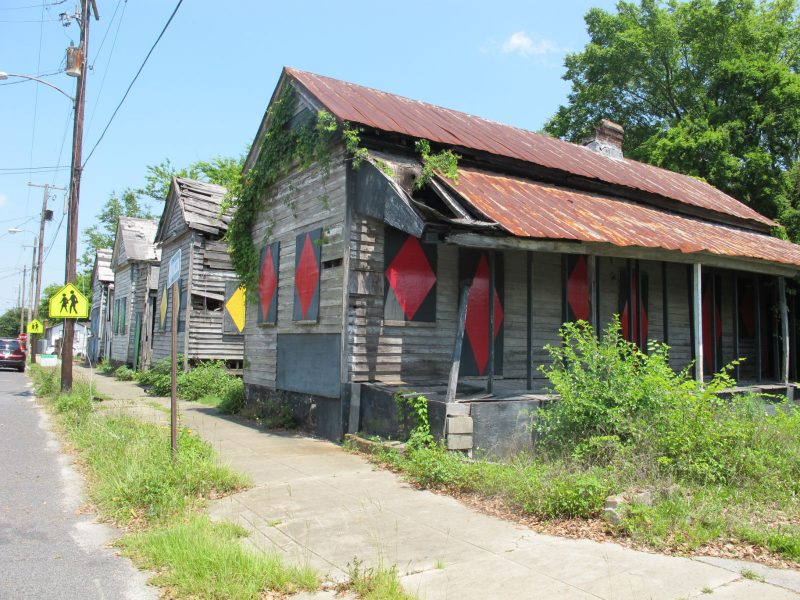
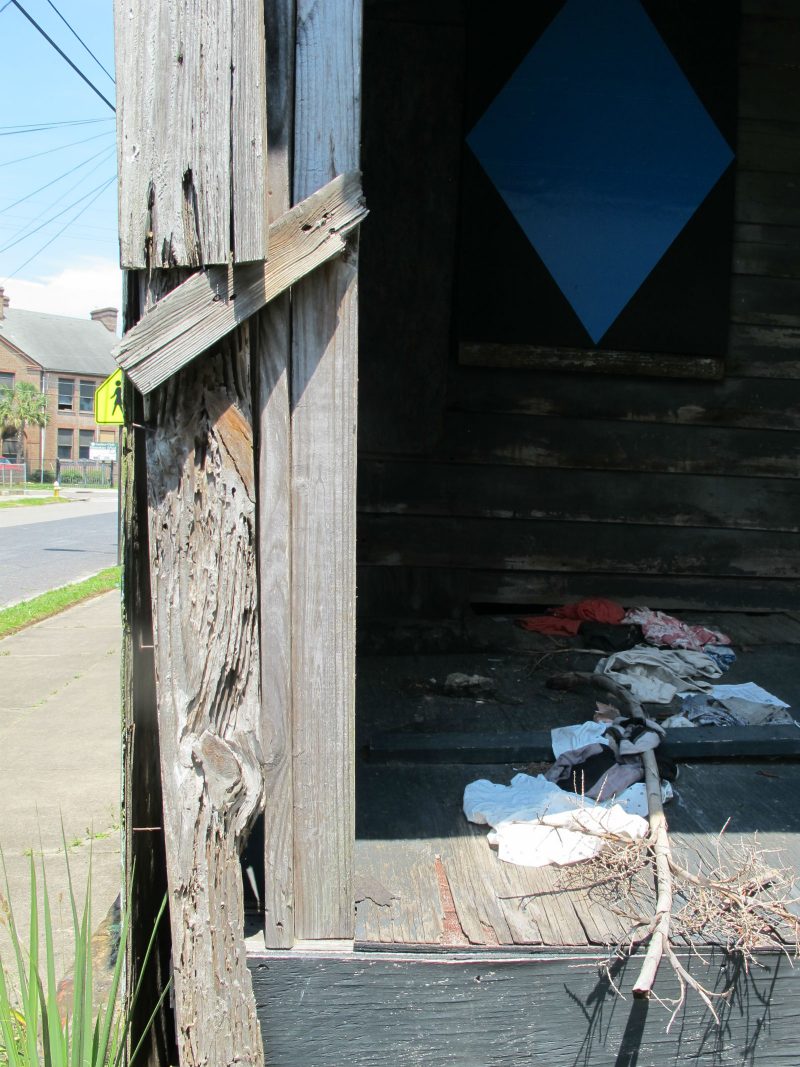
Visible neglect
The tension between past and present, even within the living memory of a (relatively) young Charlestonian like me, becomes even more clear upon visiting the Porgy Houses on the east side, still a largely black neighborhood–although there are telltale signs of gentrification, with plenty of “for sale” signs. A series of four cottages on Jackson St. are decorated with Green’s diamonds, but unlike most of the other Porgy Houses, these cottages sit vacant, their windows and doors boarded up. Unlike the well-manicured private residences, I could really explore the area around these buildings and get a palpable sense of the neglect of black history in Charleston. These decorated cottages draw attention to a part of town that visitors (and even locals) might not otherwise visit, but the local community doesn’t appear to have been brought into the process. While chatting with a man across the street from the cottages, my father asked what he thought of these Porgy Houses. He said that he didn’t realize that it was an art project; he thought the local Board of Architectural Review was trying out paint swatches. Although humorous, this is a telling anecdote because it suggests that residents have become accustomed feeling left out amidst the rapid changes and redevelopment going on across the city.
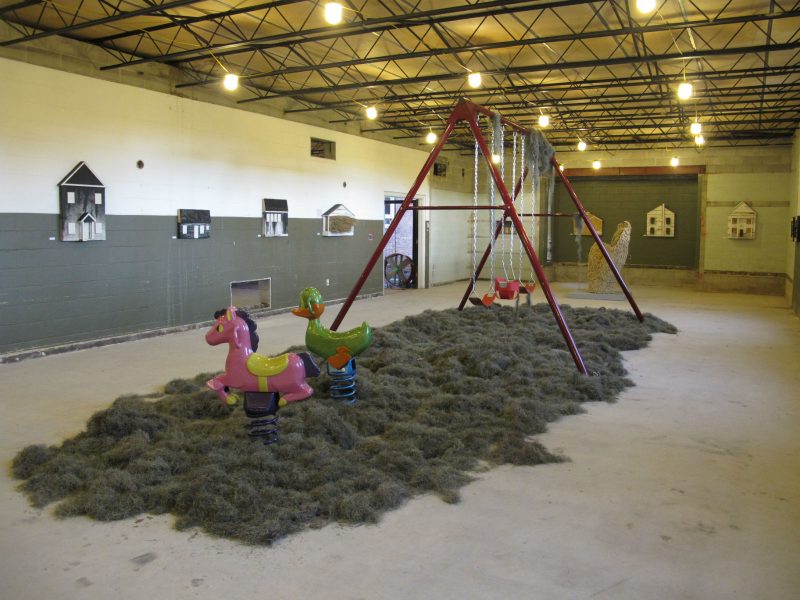
Portraits of buildings
The relationship between people and place within Charleston’s black communities is at the heart of Fletcher Williams III’s work. Williams has installed two projects, Beyond the Rainbow and Souvenir, in the fellowship hall at the former Zion Olivet Presbyterian church, soon to be transformed into a new community art space. In Beyond the Rainbow, Williams presents a series of what I think of as sculptural, architectural portraits of the predominantly black Chicora-Cherokee neighborhood in North Charleston, long troubled by poverty, violence, and neglect.
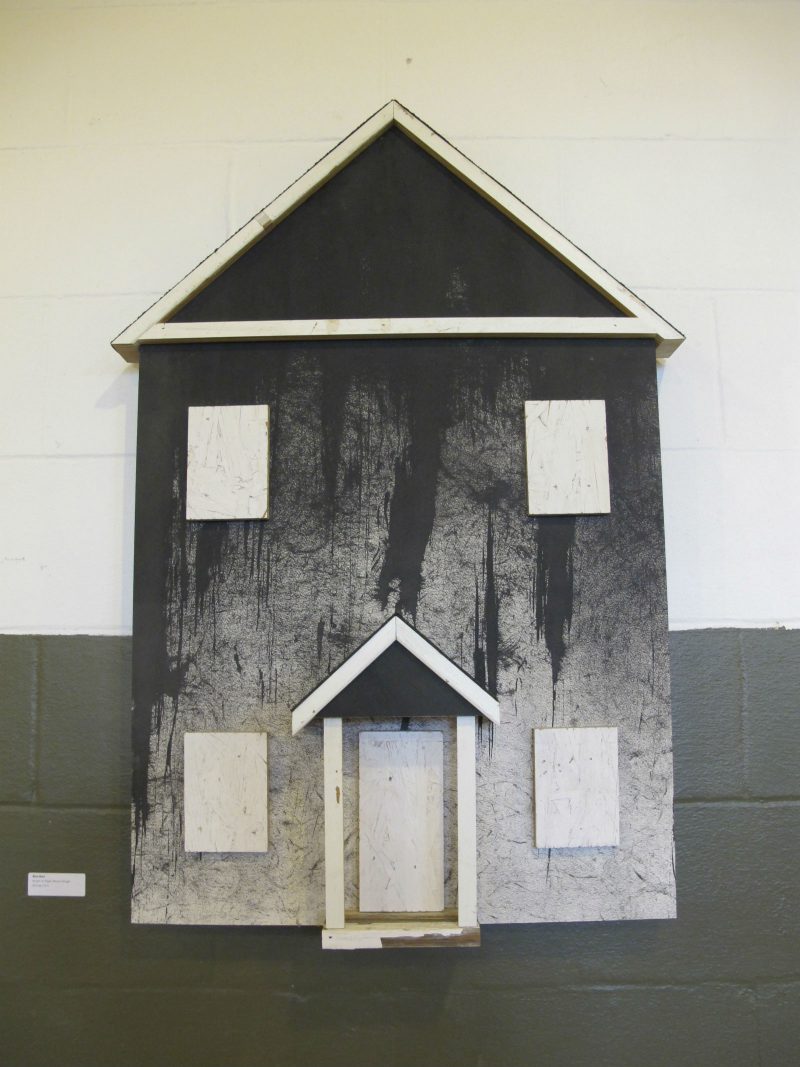
Williams assembles his portraits from found objects in Chicora-Cherokee–scraps of wood, rebar, and asphalt shingles. The houses in Beyond the Rainbow–an allusion to the series of colorful houses along Charleston’s Old Battery known as Rainbow Row–have been stripped down to monochrome façades consisting of simple geometrical elements, shallow wooden models that project only slightly from the wall. Some of the pieces, like “Blue Skies,” are covered in paper that has been painted with acrylic using local Spanish moss as the paint “brush.” Although no people are depicted in these sad, empty façades, I felt their absence keenly–particularly given the show’s setting in a church whose congregation has recently sold their downtown property to move out to the North Charleston community of Chicora-Cherokee.

Portraits of violence
Opposite the façades of Beyond the Rainbow are works from Williams’ older project, Souvenir–a darkly tongue-in-cheek reference to the Palmetto roses that unify all the pieces. These roses are made from the fronds of the local Palmetto tree (a kind of palm tree that also happens to appear on the SC state flag). Children selling these roses to tourists as souvenirs is a common sight in downtown Charleston. The anchor of Souvenir is “Oak,” a large-scale sculpture made entirely of Palmetto roses. Williams’ “Oak” appears to be dead tree, its massive branches hacked off–no longer a romantic symbol of the Old South, dripping with Spanish moss and memories of the plantation. On the wall are a series of ink and graphite drawings surrounded by specially constructed wooden frames that look like theatrical stage sets. These spare but gripping drawings depict a series of shootings across the city during the period between September, 2013, through February, 2014, right after the artist moved back to Charleston.
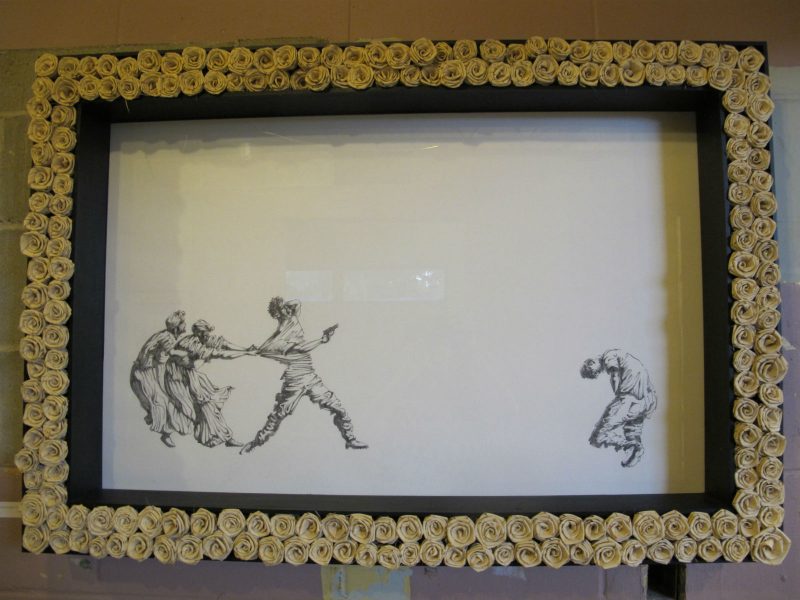
These violent vignettes capture a single moment right before or right after a shooting, reducing the details of the scene to the essentials–men, women, and guns. The spare compositions compel you to look closely at uncomfortable subject matter, involving you in the scene as a bystander–but one who is powerless to stop the inevitable pain and suffering depicted. Slightly larger than the rest of the drawings in the series, I found “Ravenel” particularly gripping. A man slumps in the far right of the composition while another man on the left points a gun as two women try to restrain him.
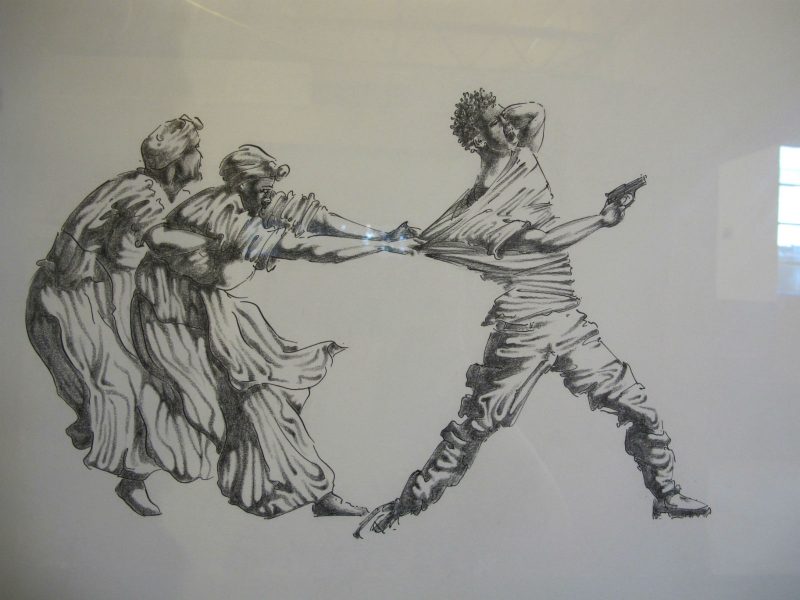
The group of three figures, two women and one man, has the rippling drapery of Hellenstic Greek sculpture, and there is a sculptural quality to Williams’ use of graphite to define light and shadow. While the young man with the gun looks contemporary, the women with their long skirts and kerchiefs look like figures out of Porgy. There is a deliberate temporal confusion here, which heightens the drama of the moment, transforming an all too common scene of violence into a Greek tragedy.
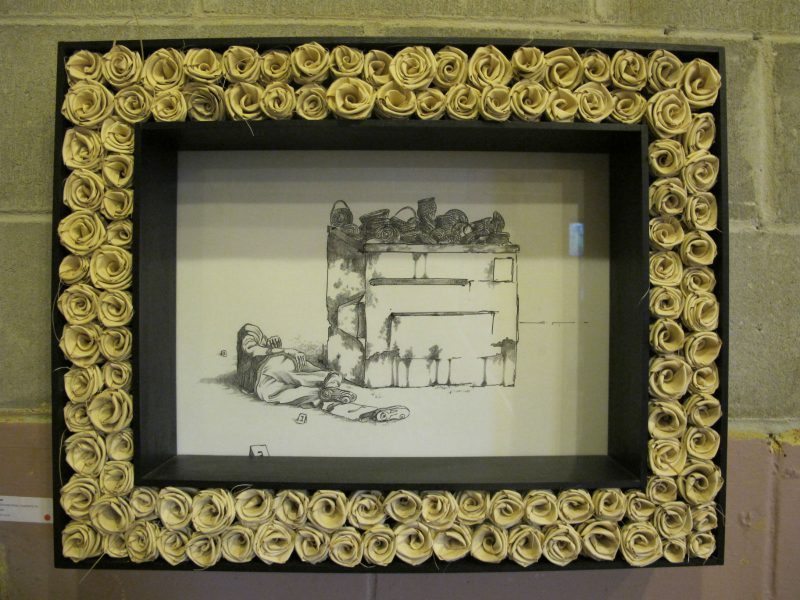
Close to home
I asked Williams if he had a personal connection to any of the shootings in the series, and he pointed to “D-road” (short for Dorchester Road), which depicts a man’s prone body lying next to a dumpster filled with sweetgrass baskets. Anyone who has been to Charleston will recognize these baskets, a traditional craft of the black Gullah-Geechee communities of the coast of SC, now largely sold to tourists. There is something jarring about seeing a dumpster full of these expensive baskets next to a dead man, suggesting the troubling commodification of culture and the tragic disposability of black bodies. Upon seeing this drawing, one of the artist’s friends said that he recognized the crime scene that Williams had rendered with such precision, down to the Nike Air Force One shoes worn by the victim. Looking at these unflinching depictions of violence and humanity, as a viewer and as a Charlestonian, I am reminded that I am not so far removed from these people or places.
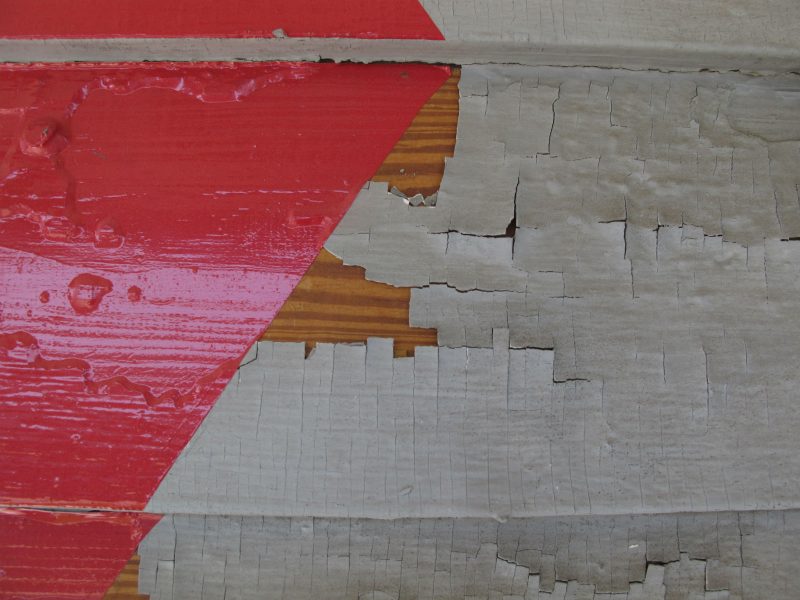
Fletcher Williams III’s work demands that we confront uncomfortable facts about both our present and our past, reflected in these lost lives and blighted neighborhoods. The façades depicted in Beyond the Rainbow hint at the individuals who lived there and the community that struggles to survive against the twin challenges of poverty and racism. Jonathan Green’s site-specific Porgy Houses likewise ask us to reflect on black history in Charleston and the whitewashed present. After the end of the Spoleto Festival, the vinyl stickers and the temporary historic markers will be removed, and no visible traces will remain of the black men and women who lived and worked in these houses for generations. We are left instead with regular reports of shootings in North Charleston, while historic downtown Charleston basks in its status as the nation’s most desirable tourist destination. No single gallery show or public art project will change this reality, but they can help us dig down through the layers of pain, conflict, and history that lie beneath the immaculate surface of so many of Charleston’s historic homes.
Jonathan Green’s Porgy Houses will be on view during the Spoleto Festival, until June 12, 2016. Fletcher Williams III’s Beyond the Rainbow will be on view at 134 Cannon Street, Charleston, SC, until June 12, 2016.



